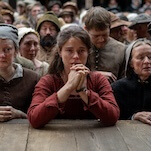Amid a miniature boom in science-fiction TV, at a time when one of the medium’s most talked-about series, regardless of genre, is a near-future nightmare that presses its audience’s faces to their handheld screens while whispering “Don’t sit so close—it’ll ruin your soul” into their ears, why revisit Lost In Space? The original saga of the space family Robinson, which ran for three seasons on CBS in the mid-1960s, isn’t a canonical title: Created by Irwin “Master Of Disaster” Allen, the show did not spawn an ever-evolving franchise like Star Trek or Doctor Who, nor did it push “the literature of ideas” to new televisual frontiers, like The Prisoner or The Twilight Zone. The original series has its charms, but they’re largely steeped in kitsch: Robert Kinoshita’s spectacular Atomic Age design for the spastic Robot, Jonathan Harris hamming it up as saboteur Dr. Zachary Smith, the rerun-reinforced delight of their catchphrases: “It does not compute,” “Warning! Warning!,” “Oh, the pain, the pain.”
But there’s also the feeling that the premise of space explorers blown off course and striving to survive in harsh, extraterrestrial territories is one that retains untapped potential, or untold stories that don’t involve space Vikings or masks inherited from This Island Earth—hence the comic-book continuations (some written by the original Will Robinson, Billy Mumy), the lackluster 1998 film adaptation, and a busted pilot from 2004. (And that’s to say nothing of a long-running Starfleet spin on similar material.) But there’s a wider precedent for this second TV voyage of the Jupiter 2, which strives to bring a little gravitas and suspense to the predicament faced by John (Toby Stephens), Maureen (Molly Parker), Will (Max Jenkins), Judy (Taylor Russell), and Penny (Mina Sundwall) Robinson. It’s in the BBC’s Doctor Who update, or, in an example that strikes closer to Lost In Space’s beloved-but-corny heart, Ronald D. Moore’s celebrated Battlestar Galactica revamp.
The problem with the Battlestar Galactica comparison is that Lost In Space isn’t exactly the nothing-to-lose mission of reinvention that Moore and Syfy embarked on by bring political and spiritual depth to ABC’s costly attempt at capitalizing on Star Wars mania. Attempting to remove the camp is one of the many things that sank the big-screen version of Lost In Space, which finds the Robinsons seeking to quell the world-domination plot of a time-traveling space spider with Gary Oldman’s face. There’s also the matter of the Jupiter 2’s youngest crew members: The show can acknowledge the terror and the peril of being stranded on an alien planet all it wants, but it’s never going to actually cross the child-endangerment threshold. Eldest Robinson child Judy nearly suffocates in a flash-frozen tomb in the series premiere, but this would be a different, crueler show if her death wasn’t narrowly averted thanks to her younger brother’s discovery of a powerful automaton.
And it’s not like the remake’s straight face is its own invention, either. Long before the original Lost In Space lapsed into the realm of murderous vegetation, it was rooted in the premise of a dying Earth, the Robinsons and company being the first colonization wave in an effort to save the human race from an overpopulated planet. Its true innovation is that, like a similarly structured, modern-day sci-fi series with a past participle in its title, “lost” here does not equal “alone.” After the requisite Netflix dithering of the opening chapters, the first season of Lost In Space solidifies around a community of survivors from the doomed vessel Resolute, their squabbling and power struggles occasionally interrupted by an attack from an alien creature or some such other white-knuckle set-piece fodder. Those survivors, including Raza Jaffrey as the colonists’ elected leader, Victor Dhar, and Cary-Hiroyuki Tagawa as a scientist colleague of Maureen’s, Hiroki Watanabe. But the show never goes full Lost in its exploration of these castaways beyond their interactions with and relation to the Lost In Space core of the Robinsons, Dr. Smith (Parker Posey, in an inspired casting choice), and Ignacio Serricchio’s waggish rendition of Major Don West, who has Poe Dameron’s stubbly good looks, plus Han Solo’s priorities and withering way with the word “princess.”
What works about Lost In Space is the sort of elementary, sci-fi-tinged adventure material that Irwin Allen would’ve served up in retina-searing colors and before shipping the props off to Voyage To The Bottom Of The Sea and Land Of The Giants: fuel-leeching eel creatures; giant, phototactic lizards; the robot that everybody just calls “Robot.” And the same three characters that came to dominate Allen’s Lost In Space dominate this one as well. The Robot, filling a Spielbergian void in Will’s life and forming a protectorship/friendship with the boy that’s part E.T., part Eleven. Matt Sazama and Burk Sharpless’ take on the Robot is a metal golem of unknown origin, all shape-shifting scalloped armor with a swirling mood ring for a face. Posey, manipulative and cunning as the stowaway Smith, sees in the Robot the opportunity to permanently conceal her own secrets. The tension between the trio recedes as attempts to escape the planet and contact the Resolute progress by inches, but it’s never anything short of Lost In Space’s sharpest articulation of the fresh start promised among the stars. Under different circumstances, the rest of humanity would’ve left Will and Smith behind; Will gives the Robot a purpose beyond the apparently violent ends in its programming.
There’s just so much padding around all of that. Even when an episode of Lost In Space clocks in at 48 minutes, the events of that episode seem to crawl by. (Why longer episodes get the full opening-title sequence and the shortest doesn’t is yet another mystery in Netflix’s bewildering indifference to opening titles.) The moments that pass between the action sequences have their pull—there’s resonance in the scenes between Molly Parker and the actors playing her kids—but pacing is not one of Lost In Space’s strong suits. The first two episodes amount to a leaden feature-length pilot, the opening hour of which is chopped up into a flashy, time-hopping hash that makes thematic, but not narrative or practical, sense.
Things get more interesting once the waylaid settlers of Alpha Centauri are reunited, but that’s held off long enough that it poses a significant risk of viewers jumping ship before the actual thrust of the season kicks in. If you’re not hooked by the Robinsons’ plight—and it’s a little tough until those eels turn up in episode three—then all that’s pulling you forward are the questions surrounding the Resolute disaster, where the robot comes from, and the disaster that sent humanity reaching for the heavens. Hunting for such answers can be amusing, but Lost In Space is at its strongest when the unknown is coming for the Robinsons, not the other way around. The Netflix series never fulfills the wasted promise of Lost In Space, but for a show that’s navigating such well-trod territory, it does turn up some intriguing unknowns.








































